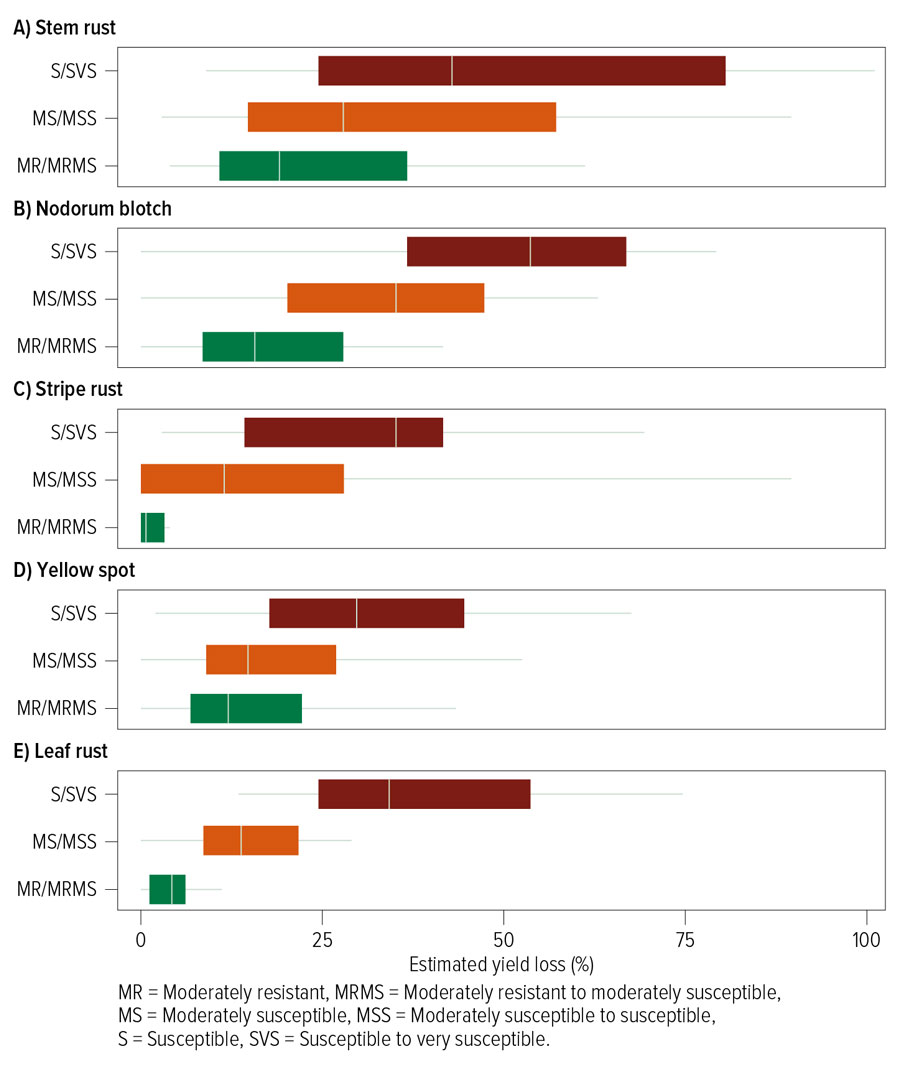Key points
- The effectiveness of partial resistance in reducing yield loss has been quantified for 13 wheat and barley diseases.
- The current resistance rating categories are good predictors of yield loss, with yield loss increasing with the susceptibility of the varieties to the particular pathogen
The challenge of weighing up the benefit of sowing varieties with resistance to one or more diseases over other traits, such as regional adaptation, is about to be helped by an online tool that compares the impact of resistance categories on the potential yield loss for different diseases in different seasons.
The model has been developed from a five-year GRDC-invested project to generate a large enough bank of data with which to build a prediction model.
The national project was led by the Western Australian Department of Primary Industries and Regional Development in collaboration with the Queensland Department of Agriculture and Fisheries, Agriculture Victoria and the NSW Department of Primary Industries. The team established 141 field trials across Australia over four years to evaluate 13 foliar and soil-borne diseases for wheat and barley.
The diseases were leaf rust, stem rust, stripe rust, yellow spot, Nodorum blotch and Septoria tritici blotch in wheat; barley leaf rust, net form net blotch, spot form net blotch and scald in barley; and crown rot and root lesion nematode (Pratylenchus neglectus and P. thornei) in both.
Each trial used five or six varieties with resistance levels (or tolerance for nematodes), typically ranging from moderately resistant moderately susceptible (MRMS) to very susceptible (VS).
These complex data sets were analysed by GRDC’s Statistics for the Australian Grains Industry (SAGI) program to generate the first comprehensive set of predictions of potential yield loss by resistance rating.
Impact on wheat
The findings for wheat foliar pathogens showed that the current resistance rating categories are good predictors of yield loss, with yield loss increasing with the susceptibility of the varieties to the particular pathogen.
Varieties with partial resistance had lower levels of disease and slower disease development, rather than delayed onset of disease.
Importantly, the amount of yield loss varied between different diseases. This means that for some diseases it may be sufficient to avoid susceptible varieties.
Disease intensity (amount of disease pressure) also plays a role in determining the extent of yield loss.
Comparing the foliar diseases of wheat, trials showed that rusts were more damaging to yield than yellow spot or Nodorum blotch (also known as Septoria nodorum blotch or Stagonospora nodorum blotch).
This was demonstrated in the WA trials by a steep drop in yield as resistance levels declined. For instance, wheat varieties with partial resistance of MR/MRMS to leaf rust showed a yield loss of zero to 11 per cent. In contrast, the S/SVS varieties showed a yield loss of 13 to 75 per cent (Figure 1).
Figure 1: The wheat foliar disease model compares the impact of resistance categories on the potential yield loss for individual diseases.

Source: Dr Manisha Shankar
Growers and advisers will soon be able to use the foliar disease model online to compare the impact of resistance categories on the potential yield loss for individual diseases across different experiments and seasons.
The model will include the wheat diseases: leaf rust, stem rust, stripe rust, yellow spot and Nodorum blotch; and the barley diseases: barley leaf rust, net form net blotch and spot form net blotch.
Ultimately, this improved understanding of the potential economic impact of genetic resistance will empower growers and advisers to make better decisions.
Cereal diseases are estimated to reduce the average annual value of Australian cereal crops by almost 20 per cent.
Varieties with partial resistance (rated MR, MRMS, MS and MSS) provide the most effective method of disease control. Until now, there has been a gap in understanding the potential yield loss associated with each resistance category. Partial resistance involves several minor genes contributing small additive effects and is mainly incomplete but more durable than single major-gene complete resistance.
More information: Dr Manisha Shankar, 08 9368 3533, manisha.shankar@dpird.wa.gov.au

























































